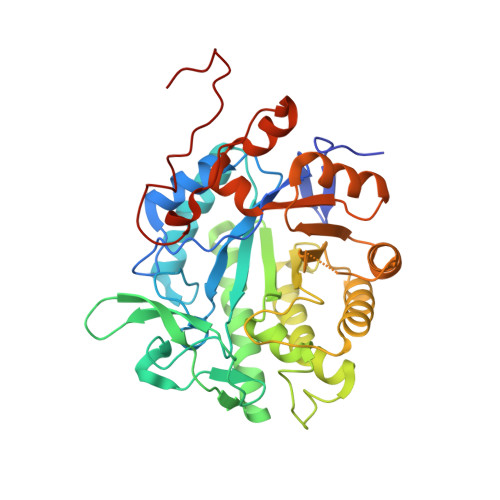Mutagenesis of morphinone reductase induces multiple reactive configurations and identifies potential ambiguity in kinetic analysis of enzyme tunneling mechanisms.
Pudney, C.R., Hay, S., Pang, J., Costello, C., Leys, D., Sutcliffe, M.J., Scrutton, N.S.(2007) J Am Chem Soc 129: 13949-13956
- PubMed: 17939663
- DOI: https://doi.org/10.1021/ja074463h
- Primary Citation of Related Structures:
2R14 - PubMed Abstract:
We have identified multiple reactive configurations (MRCs) of an enzyme-coenzyme complex that have measurably different kinetic properties. In the complex formed between morphinone reductase (MR) and the NADH analogue 1,4,5,6-tetrahydro-NADH (NADH4) the nicotinamide moiety is restrained close to the FMN isoalloxazine ring by hydrogen bonds from Asn-189 and His-186 as determined from the X-ray crystal structure. Molecular dynamic simulations indicate that removal of one of these hydrogen bonds in the N189A MR mutant allows the nicotinamide moiety to occupy a region of configurational space not accessible in wild-type enzyme. Using stopped-flow spectroscopy, we show that reduction of the FMN cofactor by NADH in N189A MR is multiphasic, identifying at least four different reactive configurations of the MR-NADH complex. This contrasts with wild-type MR in which hydride transfer occurs by environmentally coupled tunneling in a single kinetic phase [Pudney et al. J. Am. Chem. Soc. 2006, 128, 14053-14058]. Values for primary and alpha-secondary kinetic isotope effects, and their temperature dependence, for three of the kinetic phases in the N189A MR are consistent with hydride transfer by tunneling. Our analysis enables derivation of mechanistic information concerning different reactive configurations of the same enzyme-coenzyme complex using ensemble stopped-flow methods. Implications for the interpretation from kinetic data of tunneling mechanisms in enzymes are discussed.
Organizational Affiliation:
Manchester Interdisciplinary Biocentre, Faculty of Life Sciences, University of Manchester, 131 Princess Street, Manchester, M1 7DN, U.K.
















